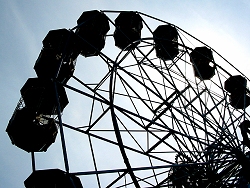|
.
However,
this agreement was not reached until November 28th 1892,
giving him less than six months until the fair opened on May 1st
1893. If this weren’t problem enough, the severe Chicago winter would
make construction even more difficult.
Despite
this, Ferris had enough belief in the project to continue. Using his
connections to assemble a group of high profile partners and investors,
work began in earnest, with parts being made at various steelworks
around Illinois, Ohio, and of course, his own firm in Pittsburgh.
|

|
| Tacky
and sensationalist? Peeking Heights is called an 'Observation
Wheel' |
The wheel
finally opened on June 21st, almost two months behind schedule. It stood
266ft tall, with an axle that ranked was as the biggest piece of steel
ever made, at 45ft long, almost 7 feet thick, and weighing 56 tons. The
motion of the wheel was perfect, disproving the engineers who said it
could not be done.
The wheel
carried 36 fully enclosed cars, each of which carried 60 people, plus a
conductor. It had cost Ferris $250,000 to build, and now it was time to
see whether enough people were willing to ride to make the investment
worthwhile. The name “Ferris Wheel” was chosen partly to reflect
it’s status as Chicago’s equivalent to the Eiffel Tower, but also to
give the wheel a sense of dignity. Ferris later said that the proposed
alternative, “Observation Wheel”, would be too sensationalist, and
would make the ride appear tacky.
He was
adamant that his creation was to be viewed not as an amusement ride, but
as an engineering feat. It was decided that a ride on the Ferris Wheel
should consist of two revolutions, one continuous, and one with constant
stops for loading and unloading.
Before
opening the ride to the public, Ferris invited journalists to ride with
him and his wife. Many of them would later describe the ride as
terrifying, mainly because of the strong winds that constantly battered
the cabins. Whether Ferris approved of his machine being described as
scary is unclear, but it failed to deter the public, and at the end of
the fair 1,453,611 tickets had been sold which, at 50 cents each, meant
the ride had taken almost three times the $250,000 that Ferris had
invested, thus making it the most successful feature of the fair.
Any
concerns for the structure’s wind resistance were proven unfounded
when a hurricane rolled in, damaging many of the fair’s exhibits, but
leaving the wheel intact. Indeed, once the wheel had opened, it operated
for the remainder of the exhibition without a single breakdown.
Sadly,
Ferris’s delight was to be short-lived. He became convinced that the
organisers had reneged on the original deal and kept a sizable portion
of the ride’s profits. After the exhibition, smaller wheels were built
at amusement parks worldwide, but Ferris was not involved in these, and
saw very little of the money from them. Much like Eiffel before him, he
tried to persuade other cities to build bigger versions of his
invention, but failed to generate any interest, due to the fact that
investors believed the original wheel to be so famous that building
their own version would be seen as simply mimicking Chicago.
Continues...
|